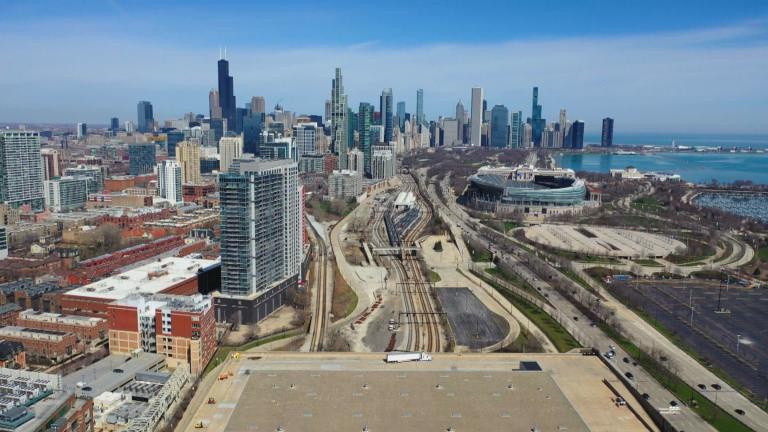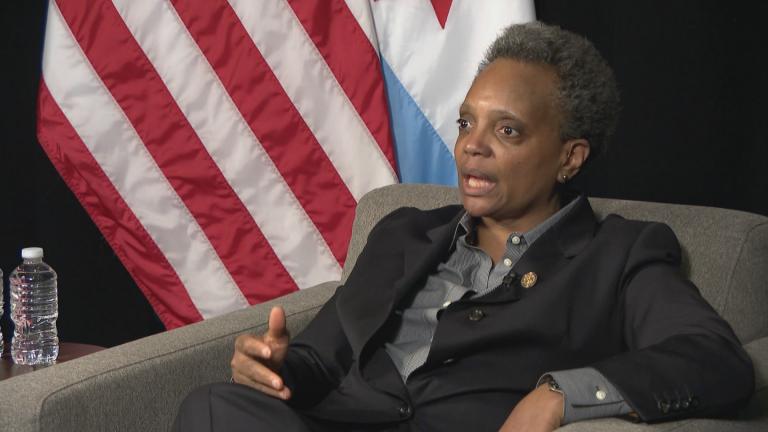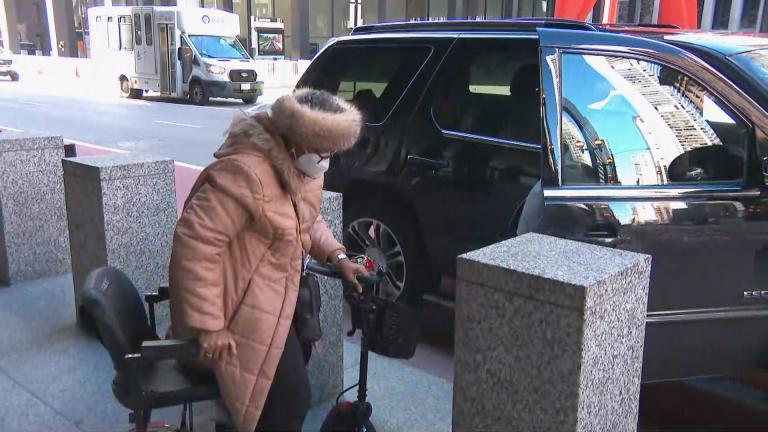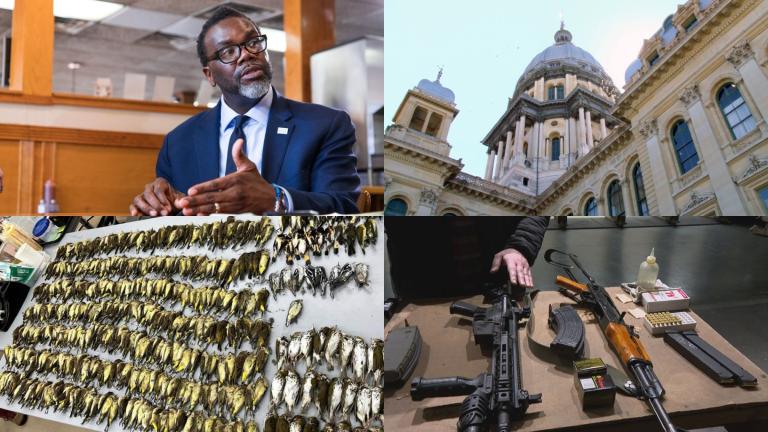Chicago officials could have prevented a plume of dust from enveloping Little Village in the early days of the COVID-19 pandemic by requiring the firms demolishing the former Crawford Power Plant to get a new permit before using explosives to bring down the a smokestack, according to a confidential report by the city’s watchdog obtained by WTTW News.
Mayor Lori Lightfoot, who will ask Chicago voters to reelect her in precisely two weeks, has repeatedly refused to make the report public, ignoring a resolution unanimously passed by the Chicago City Council in July demanding its release.
The 94-page report was completed by former Inspector General Joseph Ferguson on Sept. 27, 2021, just weeks before he left office after Lightfoot refused to reappoint him to a fourth, four-year term in office.
The report determined that city officials put Little Village residents at risk when they allowed the smokestack demolition to proceed based on a permit issued in July 2018 that did not mention the use of explosives. At the same time, other officials did not do enough to ensure the implosion did not cause a massive dust storm while others brushed off or downplayed concerns about whether the demolition should take place a month after the COVID-19 pandemic swept Chicago, according to the full report.
WTTW News is not publishing the full unredacted report because it identifies by name those who provided information to the Office of the Inspector General, known as the OIG, during the probe.
Ferguson declined to comment on the report’s content Monday when reached by WTTW News. After leaving office, Ferguson has repeatedly blasted Lightfoot as incompetent.
A spokesperson for Lightfoot initially declined to comment on the full report obtained by WTTW News, noting that Monday was a city holiday to mark President Abraham Lincoln’s birthday. Lightfoot has previously said her administration has taken the necessary steps to prevent another implosion from traumatizing a community and imperiling residents’ health.
In a statement released Tuesday afternoon, after the story's publication, a spokesperson for Lightfoot decried the release of the report to WTTW News.
"Anything that came to the public regarding the Office of Inspector General's investigatory reports was leaked, which was fundamentally wrong and undermined the integrity of the OIG process," according to the statement, which did not address the inspector general's findings that the plume could have been prevented by city employees.
"As the mayor and others stated at the time of the incident, the implosion at the former Crawford Generating Power Plant was an unacceptable event," according to the statement. "Contractor negligence and failures led to the dust cloud that created fear and trauma in Little Village. This administration took swift, public action to hold those responsible accountable."
Until now, Chicagoans have only seen the summary of the probe released by interim Inspector General William Marbeck after Ferguson’s departure.
Inspector General Deborah Witzburg told WTTW News that “confidential documents should not be publicly released outside of what the law allows.”
“That’s not the right road to transparency, and it makes our work harder,” Witzburg said. “We will continue to do everything in our power to protect those who cooperate in OIG’s investigations — that’s a sacred obligation of this work. I look forward to engaging in a responsible conversation about whether the law keeping OIG reports confidential should evolve. We’ll have that conversation in the legislative body, where it belongs.”
Ferguson urged Lightfoot to release the full report in a column published by the Chicago Tribune in August 2022.
Top officials appointed by Lightfoot rejected Ferguson’s recommendation to fire an employee of the Chicago Department of Public Health and punish two employees of the Department of Buildings responsible for approving and overseeing the implosion of the smokestack. Instead, the health department employee received a written reprimand and other employees were not disciplined.
One of the Department of Buildings employees Ferguson urged be disciplined has left the city, according to Chicago's public database of employees, while the other was promoted in November 2020. The health department employee involved in the implosion also remains on staff, according to city records.
Warning About ‘Cataclysmic’ Dust
City health officials were warned 213 days before the demolition that the “dust from an event like this is almost cataclysmic,” according to the summary. Fifty-one days before the demolition, health officials were told that dust would be “an unpreventable byproduct” of the operation, according to the report.
In addition, senior officials in the Chicago Department of Public Health predicted that the demolition would be a “disaster,” according to the report.
However, those warnings – and others – were not heeded by city officials, who gave the implosion the green light, according to the full report.
The inspector general’s probe found a “multi-agency breakdown of city regulatory oversight and constituted a knowing, bureaucratic acquiescence in an environmentally negligent demolition that generated a particulate dust cloud onsite that was predictably propelled into the residential community of Chicago’s Little Village neighborhood,” according to the full report’s conclusion.
Top officials in the Department of Buildings failed to conduct a formal review of revised plans to demolish the smokestack, while top officials in the Chicago Department of Public Health “knew or should have known” that the firm hired by Hilco to conduct the demolition had “outlined manifestly inferior dust mitigation measures prior to the implosion that significantly radically diverged” from a previous plan that had been reviewed in 2019 by city officials, according to the full report’s conclusion.
An Amended Permit
The demolition of the decommissioned Crawford Power Plant was first permitted in July 2018. That permit did not specifically allow the demolition of the smokestack, and a new permit allowing the implosion to be triggered by explosives would be warranted, according to a recommendation from a city employee to leaders of the Department of Buildings documented by the inspector general’s probe.
Instead, the 2018 permit was amended to allow the demolition of the smokestack on April 9, 2020, two days before the implosion, according to the full report.
If a second permitting process had instead been launched, it would have “forced additional, formal departmental reviews specific to the unique nature of the smokestack which, as a matter of record, did not occur during the original permitting process in 2018,” according to the full report.
That permitting would also have likely uncovered the fact that any demolition work performed MCM Management was not covered by a bond, which is designed to ensure that potential damage caused by work performed for the city by a contractor is paid for by the contractor, not the taxpayers, according to the full report.
Those failures by the Department of Buildings employees were compounded by errors by employees of the Chicago Department of Public Health, who ignored a “clear red flag” when informed that the original plans to control the dust sure to be caused by the implosion had been jettisoned after a subcontractor was fired, according to the full report.
For example, the original plan called for 24 fire trucks to surround the smokestack and soak the ground with water before the implosion. However, there were just two trucks on site when the smokestack was demolished, according to the full report.
Health department employees also ignored questions about whether the implosion should take place during the early days of the COVID-19 pandemic when statewide lockdown orders were still in place, according to the full report.
In fact, city records show that some officials suggested that the lockdown was an ideal time for the implosion, since most people were staying home and off the roads.
Ald. Mike Rodriguez, whose 22nd Ward includes the six blocks of homes that were coated by the plume of dust on April 11, 2020, said the results of the report were infuriating. Rodriguez has endorsed U.S. Rep. Jesús “Chuy” García’s bid to unseat Lightfoot.
Rodriguez, who faces Neftalie Gonzalez and Kristian Armendariz on Feb. 28 in his bid for reelection, said the implosion was clearly an example of “environmental racism” that never would have been allowed to happen in a part of the city home to white Chicagoans. Little Village is the heart of Chicago’s Latino community.
“It is unconscionable that this report has not been released by the mayor’s office,” Rodriguez said. “My community deserves transparency. I don’t think justice has been served.”
Fault and Fines
The inspector general’s probe found Hilco at fault for failing to ensure that the implosion did not endanger the health of the public and faulted officials for not taking steps to ensure a plan to protect the surrounding neighborhood was in place and would be followed.
In addition, city officials did not do enough to ensure that those who lived near the former power plant were informed about the planned implosion with enough time to object or take steps to protect themselves or their families, according to the full report.
Three firms involved in the implosion of the smokestack at the former Crawford Power Plant paid $370,000 to settle a lawsuit filed by Illinois Attorney General Kwame Raoul. In addition, city officials hit Hilco and two other firms involved in the implosion with 16 citations, which officials told the news media came with $68,000 in fines.
Hilco paid $19,500 to resolve five citations, according to city records.
Two other firms — MCM Management and Controlled Demolition Inc. — each paid an additional $17,000 to resolve citations related to the implosion.
In all, the three firms paid $53,500 to resolve 11 citations in connection with the implosion, officials said.
The resolution of those citations with fines prevented the inspector general’s office from recommending additional punishment, according to the full report.
The former Crawford power plant is now a warehouse.
During the 2019 mayoral campaign, Lightfoot vowed to root out corruption at City Hall while increasing transparency. Her campaign’s commercials vowed she would “bring in the light.”
In July 2019, the City Council approved an ordinance backed by Lightfoot that gave the city’s top lawyer the power to release investigations from the inspector general about cases involving deaths or felonies. However, Lightfoot has released no reports that detail misconduct during her time as mayor.
Several candidates for mayor reacted to the release of the inspector general's report with outrage, including U.S. Rep. Jesús "Chuy" García and Cook County Commissioner Brandon Johnson.
"Her administration’s cover up, bad decision-making, and lack of accountability is emblematic of the incompetent and corrupt decision making that we have come to expect from Lori Lightfoot,” said Congressman García.
Johnson said it was now clear why Lightfoot refused to release the report.
"Her administration displayed blatant disregard for Chicagoans’ lives, and then engaged in an old school political coverup to hide this fact from the public," Johnson said.
This story was updated at 4 p.m. Feb. 14 with additional comments.
Contact Heather Cherone: @HeatherCherone | (773) 569-1863 | [email protected]








